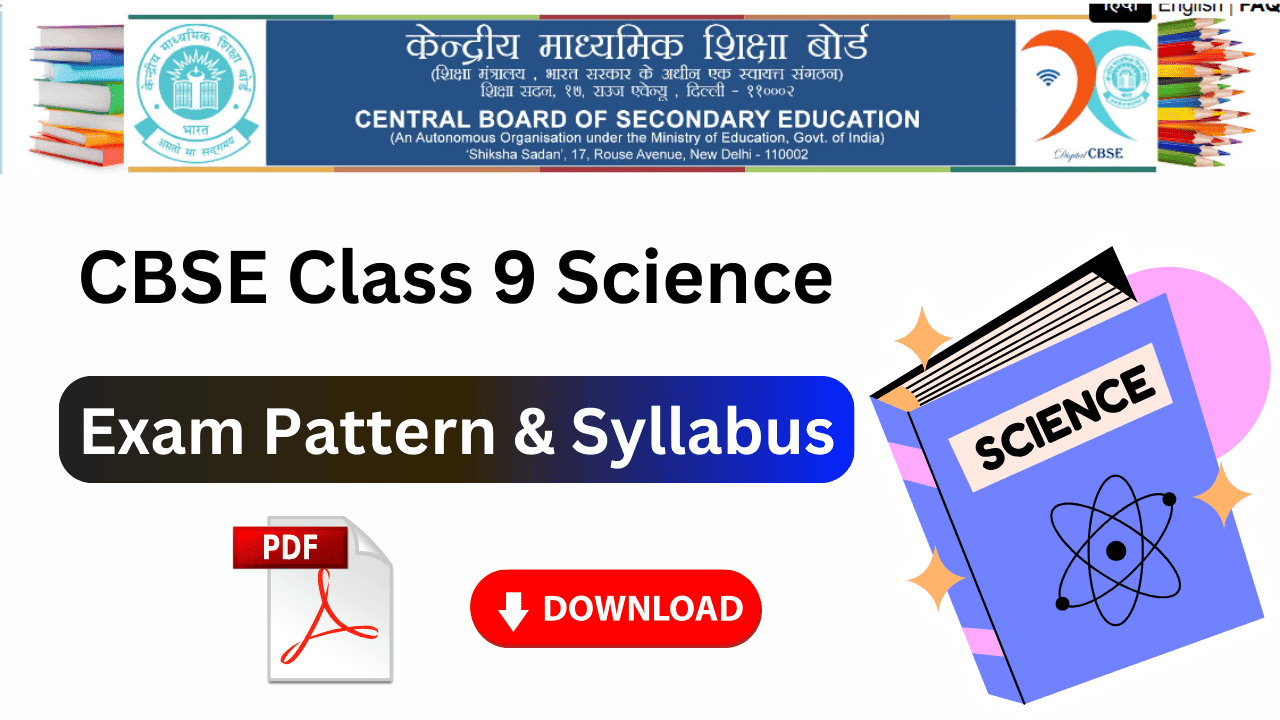Latest CBSE Class 9 Science Syllabus 2025-26 – Get the official syllabus with a chapter-wise breakdown, marking scheme, and expert study tips. Download the official PDF at the end!
Overview of CBSE Class 9 Science Syllabus 2025-26
The Class 9 CBSE syllabus for Science is crucial for board exams and sets the foundation for higher classes. The 2025-26 syllabus includes competency-based questions, increased focus on application-based learning, and internal assessments.
| Board | CBSE |
| Class | 9 |
| Session | 2025-26 |
| Subject | Science |
| Content-Type | Syllabus/Curriculum |
| Official Website | https://cbseacademic.nic.in |
Here’s a well-structured and easy-to-read version of the CBSE Class 9 Science Syllabus (2025-26):
CBSE Class 9 Science Syllabus (2025-26)
Exam Duration: 3 Hours
Total Marks: 80 (Theory) + 20 (Internal Assessment) = 100 Marks
Course Structure
| Unit | Theme | Topics | Marks |
|---|---|---|---|
| I | Matter - Its Nature and Behaviour | Matter in Our Surroundings, Is Matter Around Us Pure, Atoms & Molecules, Structure of Atom | 25 |
| II | Organization in the Living World | Cell - Basic Unit of Life, Tissues, Organs, Organ Systems, Health & Diseases (Formative Only) | 22 |
| III | Motion, Force and Work | Motion, Force & Newton’s Laws, Gravitation, Floatation, Work & Energy, Sound | 27 |
| IV | Food Production | Plant & Animal Breeding, Fertilizers, Pest Control, Organic Farming | 6 |
| Total | 80 | ||
| Internal Assessment | Projects, Practicals, Lab Work | 20 | |
| Grand Total | 100 |
Detailed Syllabus
Unit I: Matter - Its Nature and Behaviour (25 Marks)
1. Matter in Our Surroundings
- Definition of matter
- States of matter (Solid, Liquid, Gas) & their properties
- Change of state (Melting, Freezing, Evaporation, Condensation, Sublimation)
2. Is Matter Around Us Pure?
- Elements, Compounds & Mixtures
- Types of mixtures (Homogeneous & Heterogeneous)
- Physical & Chemical Changes
3. Atoms & Molecules
- Laws of Chemical Combination
- Chemical formulas, Atomic & Molecular Mass
4. Structure of the Atom
- Subatomic particles (Electrons, Protons, Neutrons)
- Atomic Number, Mass Number, Isotopes, Isobars
Unit II: Organization in the Living World (22 Marks)
1. Cell - Basic Unit of Life
- Prokaryotic & Eukaryotic Cells
- Cell Organelles (Mitochondria, Nucleus, Chloroplast, etc.)
- Cell Membrane, Cell Wall, Chromosomes
2. Tissues, Organs, Organ Systems
- Plant Tissues (Meristematic & Permanent)
- Animal Tissues (Epithelial, Muscular, Connective, Nervous)
Formative Assessment Topics (Not in Exams)
- Health & Diseases (Infectious & Non-infectious diseases, Prevention)
Unit III: Motion, Force & Work (27 Marks)
1. Motion
- Distance, Displacement, Speed, Velocity
- Acceleration, Distance-Time & Velocity-Time Graphs
- Uniform & Non-uniform Motion
2. Force & Newton’s Laws
- Newton’s Three Laws of Motion
- Inertia, Momentum, Force & Acceleration
3. Gravitation
- Universal Law of Gravitation
- Mass, Weight, Free Fall
4. Floatation
- Archimedes’ Principle, Buoyancy
5. Work, Energy & Power
- Kinetic & Potential Energy
- Law of Conservation of Energy
6. Sound
- Nature of Sound, Speed, Echo, Ultrasound
Formative Assessment Topic (Not in Exams)
- Conservation of Momentum
Unit IV: Food Production (6 Marks)
- Plant & Animal Breeding
- Fertilizers, Manures, Pest Control
- Organic Farming
Practicals (Lab Work)
- Preparation of Solutions (True, Suspension, Colloidal)
- Mixtures vs. Compounds (Iron + Sulphur Experiment)
- Physical & Chemical Changes (Burning Mg, Heating CuSO₄)
- Microscopic Study (Onion Peel, Cheek Cells)
- Tissue Identification (Plant & Animal Tissues)
- Melting & Boiling Point Determination
- Sound Reflection & Density Experiments
- Law of Conservation of Mass Verification
Key Notes:
- Formative Assessments (Health, Conservation of Momentum) are for understanding only, not exams.
- NCERT Boxed Items are for clarity but not examinable.
Best Study Tips for CBSE Class 9 Science
- Divide Your Time: Focus more on Unit III (Motion, Force & Work, 27 marks) and Unit I (Matter, 25 marks) as they carry the highest weightage.
- Daily Revision: Spend 1-2 hours daily—split between theory (reading NCERT) and practice (diagrams, formulas).
- Use NCERT: Stick to the NCERT Class 9 Science textbook—it’s the key resource for theory and exam questions.
- Lab Work: Perform all 8 practicals (e.g., onion peel slide, solution prep) and note observations for internal marks.
- Diagrams: Practice neat diagrams (e.g., cells, sound waves) for better scores in descriptive questions.
- Sample Papers: Solve past papers to master time management (3 hours) and question patterns.
Download CBSE Class 9 Science Syllabus 2025-26 PDF
Click the button below to download the official CBSE syllabus PDF for 2025-26.
📂 Download CBSE Class 9 Science Syllabus PDF
🔍 Related Guides
CBSE Class 9 English Language & Literature Syllabus 2025-26
CBSE Class 9 Computer Applications Syllabus 2025-26
CBSE Class 9 Maths Syllabus 2025-26
CBSE Class 9 Hindi A Syllabus 2025-26
CBSE Class 9 Hindi B Syllabus 2025-26
CBSE Class 9 SST Syllabus 2025-26
Stay Updated!
Join our Telegram/WhatsApp group for CBSE updates, free notes, and exam tips!
Bookmark this page & keep revising smartly!
Frequently Asked Questions
What topics are excluded from the final exam?
Health & Diseases (Unit II) and Conservation of Momentum (Unit III) are for formative assessment only, not the 80-mark exam.
Is the NCERT textbook enough for preparation?
Yes, the NCERT Class 9 Science book covers the entire syllabus and is sufficient for theory and practicals.
Are diagrams important in the exam?
Yes, neat and labeled diagrams (e.g., cells, sound waves) can boost marks in descriptive answers.
How much time should I spend daily on Science?
Spend 1-2 hours daily—1 hour on theory (reading/notes) and 30-60 minutes on practicals/numericals.
Do I need to memorize everything in the NCERT book?
No, skip boxed items (for clarity only) and formative topics (e.g., Health & Diseases) for the final exam.
